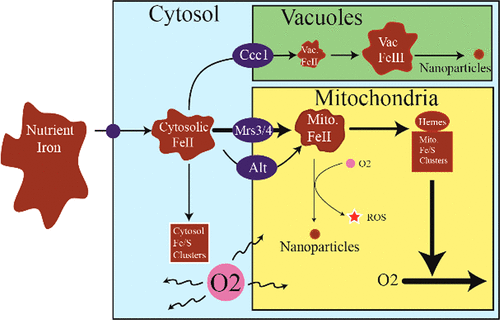当前位置:
X-MOL 学术
›
Biochemistry
›
论文详情
Our official English website, www.x-mol.net, welcomes your feedback! (Note: you will need to create a separate account there.)
Recovery of mrs3Δmrs4Δ Saccharomyces cerevisiae Cells under Iron-Sufficient Conditions and the Role of Fe580
Biochemistry ( IF 2.9 ) Pub Date : 2018-01-04 00:00:00 , DOI: 10.1021/acs.biochem.7b01034 Michael J. Moore 1 , Joshua D. Wofford 1 , Andrew Dancis 2 , Paul A. Lindahl 1, 3
Biochemistry ( IF 2.9 ) Pub Date : 2018-01-04 00:00:00 , DOI: 10.1021/acs.biochem.7b01034 Michael J. Moore 1 , Joshua D. Wofford 1 , Andrew Dancis 2 , Paul A. Lindahl 1, 3
Affiliation

|
Mrs3 and Mrs4 are mitochondrial inner membrane proteins that deliver an unidentified cytosolic iron species into the matrix for use in iron-sulfur cluster (ISC) and heme biosynthesis. The Mrs3/4 double-deletion strain (ΔΔ) grew slowly in iron-deficient glycerol/ethanol medium but recovered to wild-type (WT) rates in iron-sufficient medium. ΔΔ cells grown under both iron-deficient and iron-sufficient respiring conditions acquired large amounts of iron relative to WT cells, indicating iron homeostatic dysregulation regardless of nutrient iron status. Biophysical spectroscopy (including Mössbauer, electron paramagnetic resonance, and electronic absorption) and bioanalytical methods (liquid chromatography with online inductively coupled plasma mass spectrometry detection) were used to characterize these phenotypes. Anaerobically isolated mitochondria contained a labile iron pool composed of a nonheme high-spin FeII complex with primarily O and N donor ligands, called Fe580. Fe580 likely serves as feedstock for ISC and heme biosynthesis. Mitochondria from respiring ΔΔ cells grown under iron-deficient conditions were devoid of Fe580, ISCs, and hemes; most iron was present as FeIII nanoparticles. O2 likely penetrates the matrix of slow-growing poorly respiring iron-deficient ΔΔ cells and reacts with Fe580 to form nanoparticles, thereby inhibiting ISC and heme biosynthesis. Mitochondria from iron-sufficient ΔΔ cells contained ISCs, hemes, and Fe580 at concentrations comparable to those of WT mitochondria. The matrix of these mutant cells was probably sufficiently anaerobic to protect Fe580 from degradation by O2. An ∼1100 Da manganese complex, an ∼1200 Da zinc complex, and an ∼5000 Da copper species were also present in ΔΔ and WT mitochondrial flow-through solutions. No lower-mass copper complex was evident.
中文翻译:

铁充足条件下mrs3Δmrs4Δ酿酒酵母细胞的回收及Fe 580的作用
Mrs3和Mrs4是线粒体内膜蛋白,可将未知的胞质铁传递到基质中,用于铁硫簇(ISC)和血红素的生物合成。在缺少铁的甘油/乙醇培养基中,Mrs3 / 4双缺失菌株(ΔΔ)生长缓慢,但在有铁的培养基中恢复至野生型(WT)速率。在铁缺乏和铁充足的呼吸条件下生长的ΔΔ细胞相对于WT细胞获得了大量的铁,表明铁体内稳态失调,而与营养铁状态无关。使用生物物理光谱学(包括Mössbauer,电子顺磁共振和电子吸收)和生物分析方法(具有在线感应耦合等离子体质谱检测的液相色谱法)来表征这些表型。主要具有O和N供体配体的II型络合物,称为Fe 580。Fe 580可能充当ISC和血红素生物合成的原料。在缺铁条件下生长的呼吸性ΔΔ细胞的线粒体不含Fe 580,ISC和血红素。大多数铁以Fe III纳米粒子的形式存在。O 2可能会渗透到呼吸缓慢,铁缺乏的ΔΔ细胞生长缓慢的基质中,并与Fe 580反应形成纳米颗粒,从而抑制ISC和血红素的生物合成。铁充足的ΔΔ细胞的线粒体包含ISC,血红素和Fe 580与野生型线粒体的浓度相当。这些突变细胞的基质可能足够厌氧,以保护Fe 580不受O 2降解。ΔΔ和WT线粒体流通液中还存在约1100 Da的锰配合物,约1200 Da的锌配合物和约5000 Da的铜。没有发现低质量的铜络合物。
更新日期:2018-01-04
中文翻译:

铁充足条件下mrs3Δmrs4Δ酿酒酵母细胞的回收及Fe 580的作用
Mrs3和Mrs4是线粒体内膜蛋白,可将未知的胞质铁传递到基质中,用于铁硫簇(ISC)和血红素的生物合成。在缺少铁的甘油/乙醇培养基中,Mrs3 / 4双缺失菌株(ΔΔ)生长缓慢,但在有铁的培养基中恢复至野生型(WT)速率。在铁缺乏和铁充足的呼吸条件下生长的ΔΔ细胞相对于WT细胞获得了大量的铁,表明铁体内稳态失调,而与营养铁状态无关。使用生物物理光谱学(包括Mössbauer,电子顺磁共振和电子吸收)和生物分析方法(具有在线感应耦合等离子体质谱检测的液相色谱法)来表征这些表型。主要具有O和N供体配体的II型络合物,称为Fe 580。Fe 580可能充当ISC和血红素生物合成的原料。在缺铁条件下生长的呼吸性ΔΔ细胞的线粒体不含Fe 580,ISC和血红素。大多数铁以Fe III纳米粒子的形式存在。O 2可能会渗透到呼吸缓慢,铁缺乏的ΔΔ细胞生长缓慢的基质中,并与Fe 580反应形成纳米颗粒,从而抑制ISC和血红素的生物合成。铁充足的ΔΔ细胞的线粒体包含ISC,血红素和Fe 580与野生型线粒体的浓度相当。这些突变细胞的基质可能足够厌氧,以保护Fe 580不受O 2降解。ΔΔ和WT线粒体流通液中还存在约1100 Da的锰配合物,约1200 Da的锌配合物和约5000 Da的铜。没有发现低质量的铜络合物。


























 京公网安备 11010802027423号
京公网安备 11010802027423号